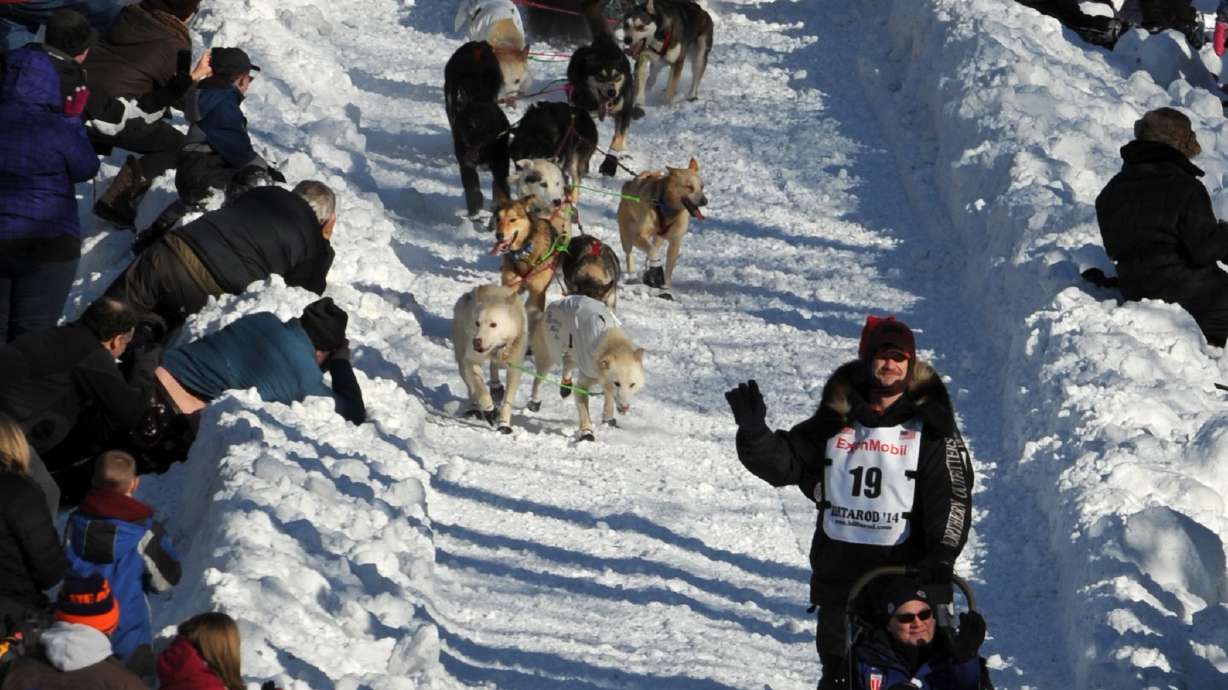Estimated read time: 5-6 minutes
This archived news story is available only for your personal, non-commercial use. Information in the story may be outdated or superseded by additional information. Reading or replaying the story in its archived form does not constitute a republication of the story.
ANCHORAGE, Alaska (AP) — Anchorage musher Scott Janssen, home from the Iditarod with a broken ankle, will be among the first to tell you that one of the benefits of mushing nearly a thousand miles across Alaska are stunning views.
Among the most visual come early in the race, in the Dalzell Gorge passage and eventually across the Farewell Burn, the site of a 1.5 million acre forest fire in 1978.
"There's a whole lot of heaven" along that part, Janssen said of the trail that goes through the Alaska Range, not too far from Mount McKinley.
But on Tuesday, as he traveled between the Rohn and Nikolai checkpoints, he saw another side — the musher was knocked unconscious when his sled turned over and his head hit a tree stump.
But that was only the beginning of his harrowing ordeal. Not too soon after, he had to be rescued from the wilderness after his boot was covered in ice and he slipped, breaking his ankle trying to round up a loose dog.
"I made it through the worst part of the trail only to slip on the ice and break my foot," Janssen told The Associated Press on Wednesday as he recuperated.
Treacherous trail conditions with little snow have marked the early part of this year's Iditarod, which started Sunday with 69 mushers. The nearly 1,000-mile race spans two mountain ranges, dangerous wilderness and the wind-whipped Bering Sea coast.
Janssen's ordeal began Tuesday when he crashed his sled after he said he bumped across rocks all along the trail. He lay unconscious for at least an hour and awoke to find his sled nearby and his dogs huddled next to him, covered in light snow.
As he dismantled his broken seat to stuff into his sled, another musher came along. Janssen asked him the time, and couldn't believe an hour, if not two, had passed.
"I tripped over there, went full-speed and hit my head on that stump," he said he told the musher. "I think I went night-night for awhile."
After caring for his dogs, Janssen fixed his sled and continued on. He made it to Tin Creek and estimated he had only about 7 more miles of nasty trail until it turned good again.
But one of his dogs, Hooper, got loose from the line and took off in the wild about 40 miles from the Nikolai checkpoint.
Janssen said he loosely anchored his sled and tried to call Hooper as he crossed a frozen creek. But just as Hooper heeded the call and trotted back to his place in line, Janssen fell.
"I slipped on the ice, and bang, that was it," he said. "Then I just laid there on the ice because I could not get back across the water to get back to my sled."
He lay there for about 45 minutes before another musher, St. Anne, Jamaica, native Newton Mashall, came along.
"I said, 'Help! Help,' and Newton comes walking up and said, 'Yeah, mon. How you doing?' I said, 'I'm just lying around, kicking back,'" Janssen said.
Marshall was able to retrieve a snowsuit and Janssen's sleeping bag from his sled, helping the injured musher into both. Janssen said hypothermia was setting in at that point.
After that, Janssen said he encouraged Marshall to get back on the trial and keep racing, but Marshall wouldn't budge until help arrived. Mushers carry mandatory GPS units that have an emergency button on them, which Janssen said he pushed.
"I had 15 dogs I have to take care of; no way I could responsibly mush in the pain I was in," he said.
Later, film crews for the Iditarod website came on the trail and stayed with Janssen until an Alaska Air National Guard helicopter arrived to fly him to an Anchorage hospital.
Janssen is among about a dozen mushers who have dropped out of this year's race. Iditarod officials also removed a Canadian musher because of injuries.
Janssen also had a frightening experience during the 2012 Iditarod. During that race, he had to give one of his dogs mouth-to-snout resuscitation after the animal collapsed while the team was going down a decline in the Dalzell Gorge. The dog survived.
Warm weather and light snow near the gorge led officials to briefly consider moving the start of this year's race from the Anchorage area hundreds of miles north to Fairbanks. However, the decision was made late last month to leave the start in Willow, because conditions had improved.
Janssen said the area had snow when that decision was made but not when mushers arrived. He talked of bouncing off rocks on the trail, driving a team on gravel and going "across these rivers that were like smooth ice."
"I'm very disappointed we didn't leave out of Fairbanks," he said, though he doesn't fault the trail, trailbreakers or Iditarod officials.
"It would have just been another race had we left out of Fairbanks."
Janssen has lived in Alaska and been an active outdoorsman for nearly three decades, competing in three previous Iditarods. He hoped he'd never find himself in a situation where he had to be rescued.
But he said there's one consolation.
"I can always wear the badge of honor that I made it over the pass on the worst year in the 42-year history of the Iditarod."
Copyright © The Associated Press. All rights reserved. This material may not be published, broadcast, rewritten or redistributed.








